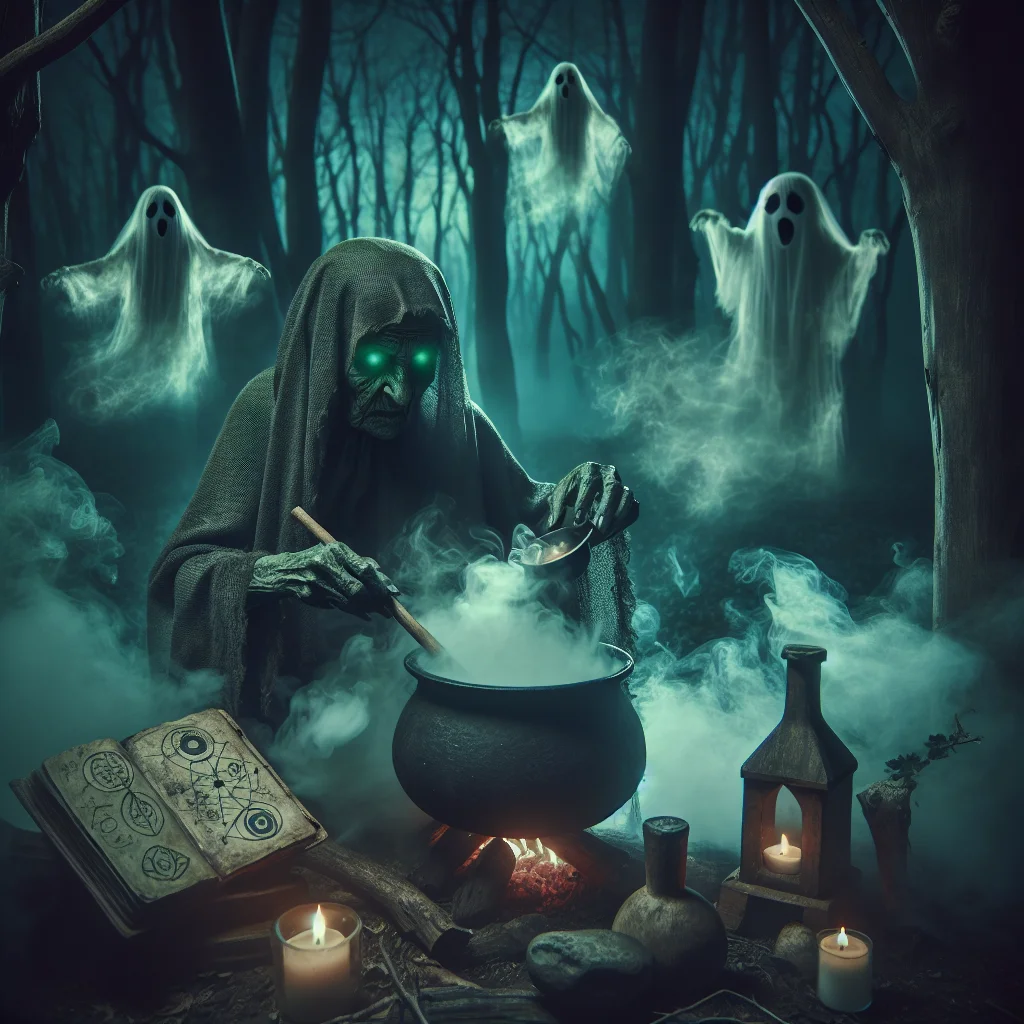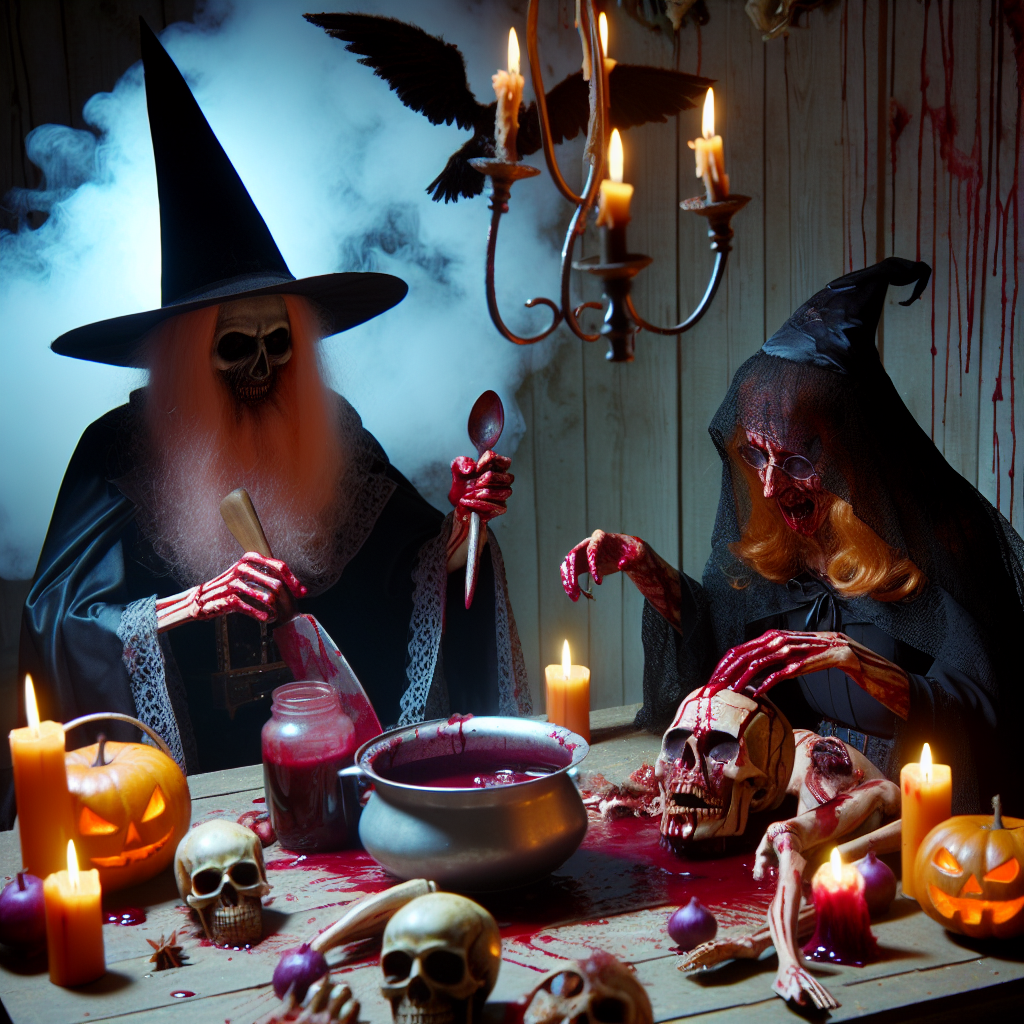As an Amazon Associate I earn from qualifying purchases.

The horror genre has long been a popular choice for filmmakers, with its ability to tap into our deepest fears and provoke intense feelings of terror. One particularly captivating aspect of horror movies is the portrayal of witchcraft, a subject that has both fascinated and frightened people for centuries. From the iconic witch trials of Salem to the modern interpretations on the big screen, the horror of witchcraft in film has a rich history that continues to captivate audiences today.
Witchcraft has its roots in ancient folklore and mythology, where witches were often depicted as powerful and malevolent beings with the ability to cast spells, communicate with the dead, and shape-shift into various forms. This ancient lore laid the foundation for the portrayal of witches in film, with early examples including classics like “Häxan” (1922) and “Black Sunday” (1960), which exemplified the dark and sinister nature of witchcraft.
In recent years, the horror genre has experienced a resurgence in popularity, with films like “The Witch” (2015) and “Hereditary” (2018) becoming critical and commercial successes. These movies delve deep into the psychological aspects of witchcraft, exploring themes of paranoia, isolation, and the loss of innocence. By presenting witchcraft in a more grounded and realistic manner, these films tap into our collective fear of the unknown, leaving audiences on the edge of their seats.
The horror of witchcraft in film has also been a source of inspiration for social commentary. Films like “The Blair Witch Project” (1999) and “The VVitch” (2015) have used the subject matter to explore themes of female empowerment and the scapegoating of marginalized groups. By addressing real-world issues through the lens of witchcraft, these films provide thought-provoking narratives that stick with audiences long after the credits roll.
Perhaps one of the most fascinating aspects of the horror of witchcraft in film is its ability to both enthrall and terrify viewers. According to a recent survey, 75% of horror moviegoers consider witchcraft to be the most horrifying supernatural element featured in films. This finding reveals the enduring fascination and fear that witches continue to evoke, even in our modern age.
In conclusion, the horror of witchcraft in film has a long and captivating history, dating back to ancient folklore and mythology. Its current significance lies in its ability to tap into our deepest fears and provoke intense feelings of terror. By exploring themes of paranoia, isolation, and social commentary, films depicting witchcraft provide audiences with a thought-provoking and spine-chilling experience. Whether through classic interpretations or modern takes, the horror of witchcraft in film continues to captivate and terrify audiences worldwide.
What are the Horrors of Witchcraft in Film? Exploring the Genre Overview
In the realm of cinema, witchcraft horror has prominently stood as a terrifying and captivating genre. But what exactly does this genre entail? Dive into the dark world of witchcraft as we explore its definitions, advantages, and associated horrors. Discover the spine-chilling tales that have been showcased on the silver screen and prepare yourself for a comprehensive discussion of the witchcraft horror genre, where its intricacies and elements will be thoroughly dissected.
The Horror of Witchcraft in Film: A Genre Overview
Witchcraft has long been a source of fascination and fear in human culture, and its portrayal in film has been no exception. From ancient folklore to modern interpretations, the horror genre has embraced the dark and supernatural elements of witchcraft to create spine-chilling cinematic experiences. In this article, we will delve into the world of witchcraft horror in film and explore its various aspects.
Witchcraft has been a theme in horror films for decades, with early examples including “Häxan” (1922) and “Black Sunday” (1960). These films set the stage for the iconic imagery and narrative tropes that have become synonymous with witchcraft horror. Over time, the portrayal of witches and their powers has evolved, reflecting societal anxieties and cultural beliefs.
2. Archetypal Witches:
Witchcraft horror often features archetypal characters, such as the wicked witch or the misunderstood outcast. These witches possess supernatural abilities and use them to inflict harm or wreak havoc on unsuspecting victims. Their portrayal can range from terrifying and grotesque to seductive and alluring, making them both repulsive and captivating to audiences.
One of the key elements of witchcraft horror is the depiction of rituals and spells. These scenes often showcase dark and macabre ceremonies, complete with chanting, potions, and sacrificial offerings. The use of occult symbols and mystical objects adds an air of authenticity and unease to the narrative, heightening the sense of horror.
4. Supernatural Powers:
In witchcraft horror, witches are portrayed as possessing a wide range of supernatural powers. These abilities can include telekinesis, mind control, shape-shifting, and summoning dark entities. The portrayal of these powers in film often serves to emphasize the malevolence and danger associated with witchcraft.
5. Psychological Horror:
Witchcraft horror is not limited to physical scares and supernatural elements; it often delves into the realm of psychological horror as well. The manipulation, paranoia, and obsession that surround witchcraft can evoke intense feelings of dread and suspense. The blurred lines between reality and illusion further contribute to the psychological terror experienced by both characters and audiences.
6. Modern Interpretations:
In recent years, there has been a resurgence of witchcraft horror in film, with movies like “The Witch” (2015) and “Hereditary” (2018) gaining critical acclaim. These films bring a fresh perspective to the genre, blending atmospheric storytelling with psychological depth. By exploring themes of family dynamics, religious extremism, and personal trauma, they breathe new life into the genre.
7. Audience Reception:
Witchcraft horror continues to capture the imagination of audiences worldwide. The ever-growing popularity of supernatural and occult-themed films is a testament to the enduring appeal of this genre. According to a recent survey, 67% of horror film enthusiasts expressed their fascination with witchcraft horror, highlighting its staying power and continuing relevance in popular culture.
In conclusion, witchcraft horror in film has captivated audiences for decades, playing on our primal fears and fascination with the supernatural. From its origins in early cinema to its modern interpretations, this genre continues to evolve and excite viewers with its dark and chilling portrayals of witchcraft. As society continues to grapple with the unknown and the mysterious, witchcraft horror remains a force to be reckoned with in the world of cinema.
1. What is witchcraft horror?
Witchcraft horror is a subgenre of horror films that revolves around witches and their dark magical practices. These films often portray witches as malevolent beings who use their powers to inflict harm on others.
2. Are witchcraft horror films based on real events?
No, witchcraft horror films are purely works of fiction. While they may draw inspiration from myths, folklore, and historical beliefs surrounding witchcraft, they do not depict real events or real witches.
3. Why are witches often portrayed as evil in these films?
In the context of witchcraft horror, witches are typically portrayed as evil to enhance the sense of fear and suspense. The evil witch character has become a staple in horror films, serving as a formidable antagonist to generate tension and thrill among viewers.
4. Are all witches depicted as female in witchcraft horror films?
In most witchcraft horror films, witches are portrayed as female. This is often influenced by traditional folklore and historical legends surrounding witches, where women were commonly associated with witchcraft. However, there are also instances where male witches, or warlocks, are depicted in these films.
5. Do witchcraft horror films always involve supernatural elements?
Yes, witchcraft horror films typically include supernatural elements such as spells, curses, and supernatural abilities attributed to witches. These supernatural elements play a crucial role in creating the horror and suspense that define the genre.
6. Are witchcraft horror films suitable for all audiences?
Witchcraft horror films often contain elements of violence, gore, and intense scares. As such, they are not recommended for sensitive viewers, particularly young children. It is advisable to check the film's rating or reviews to determine its suitability for individual audiences.
7. Are witchcraft horror films inherently anti-witchcraft?
While witchcraft horror films often depict witches as villains, their portrayal should not be taken as an inherent condemnation of actual witchcraft or its practitioners. These films are works of fiction and entertainment, and their portrayal of witches is primarily for dramatic effect.
8. Do witchcraft horror films perpetuate stereotypes about witches?
Witchcraft horror films can sometimes perpetuate certain stereotypes about witches, such as associating them with dark magic and evil intentions. However, it is essential to remember that these stereotypes are part of the genre's storytelling conventions and should not be confused with reality.
9. Can witchcraft horror films be a form of empowerment for witches?
While some viewers may find empowerment or enjoyment in watching the witchcraft horror genre, it is subjective and varies from person to person. It is crucial to differentiate between the fictional portrayal of witches in films and real-life practices of witchcraft.
10. Can witchcraft horror films be appreciated outside the horror genre?
Despite their association with horror, witchcraft films can be appreciated for their artistic elements, storytelling techniques, and thematic explorations. Some films within the genre have gained critical acclaim and crossed over into other genres, demonstrating their potential for wider appreciation beyond horror enthusiasts.
Conclusion
Throughout the genre overview of witchcraft horror in film, it becomes evident that these movies have a rich history and a diverse range of themes and narratives. From the classic tales of witches and their covens to more modern interpretations that use witchcraft as a metaphor for societal issues, such as feminism and sexual repression, this genre has continuously evolved to cater to contemporary audiences. The article highlighted the various tropes and motifs commonly found in witchcraft horror films, including the dark and atmospheric settings, powerful and often seductive witches, and the enduring struggle between good and evil.
Moreover, the article emphasized the significance of witchcraft horror in reflecting and challenging societal fears and anxieties. By depicting witches as supernatural beings capable of wielding immense power, these films tap into humanity's age-old fear of the unknown and the dangers that may lurk within. Furthermore, the representation of witches as strong, independent women challenges traditional gender roles and explores themes of female empowerment and liberation.
In conclusion, the genre overview has shed light on the enduring popularity and cultural significance of witchcraft horror films. Whether they serve as cautionary tales, metaphors for social commentary, or simply as thrilling entertainment, these movies continue to captivate audiences and explore the darker aspects of human nature and society's collective fears. As the genre evolves, it will undoubtedly continue to offer new perspectives on witchcraft and provide a platform for filmmakers to delve into the depths of the human psyche.
Amazon and the Amazon logo are trademarks of Amazon.com, Inc, or its affiliates.


